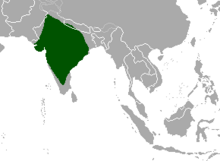Nilgau antelope
| Nilgau antelope | ||||||||||||
|---|---|---|---|---|---|---|---|---|---|---|---|---|

Nilgau antelope ( Boselaphus tragocamelus ) |
||||||||||||
| Systematics | ||||||||||||
|
||||||||||||
| Scientific name of the genus | ||||||||||||
| Boselaphus | ||||||||||||
| Blainville , 1816 | ||||||||||||
| Scientific name of the species | ||||||||||||
| Boselaphus tragocamelus | ||||||||||||
| ( Pallas , 1766) |
The Nilgau antelope or Nilgai antelope ( Boselaphus tragocamelus ), usually only briefly referred to as Nilgau or Nilgai , is an Asian antelope species .
features
With a shoulder height of 140 cm and a weight of 300 kg, the Nilgau is a very large antelope. The males are on average a fifth larger than the females. Only the males have horns; these measure about 20 cm and are short and spear-like. The fur is gray on top and whitish on the underside. Only a tuft of elongated hair on the throat and the tip of the tail are black. The males have a bluish tinge in their fur.
distribution
Today the Nilgau is largely restricted to India and southeastern Pakistan . It has been eradicated in Bangladesh , but has become rare in Nepal due to habitat destruction. It still occurs in the Suklaphanta game reserve , which borders directly on the border with India. Only from bone finds we know that this antelope still existed in Western Asia and Egypt until historical times ; there she died around 500 BC From unknown cause.
The preferred habitat are forests.
Way of life
Older males are loners; on the other hand, females and young animals form herds of about ten animals. Younger males form their own associations or join the female associations. During the mating season, the males visit the groups of females and, if necessary, drive away other males that are there. Often it comes to ritualized fights in which the necks are braced against each other. Serious fights with the horns are rare. A male tries to gather around several females and to mate with them.
Humans and Nilgau antelopes
In Hinduism , the Nilgau was classified as a close relative of the " Holy Cow " because of its resemblance to domestic cattle and was therefore not subjected to any persecution for a long time. Since 1900, however, the populations have mainly declined due to habitat destruction. The population in India is estimated by the IUCN at 100,000, in Pakistan they are significantly lower. In the 1930s, Nile Gau antelopes were released in southern Texas and have since spread so widely that their populations are estimated at 37,000. The species is considered harmless.
Surname

The name nilgau or nilgai is derived from the Hindi designation nilgai ( नीलगाई ab), which means literally "blue cow". In English there is also the term bluebuck ("Blaubock"). In German usage, however, another antelope from the group of billy goats is called the blue goat .
In India, the authorities have tried to establish the name Rojad as a new name for the Nilgau antelope in order to avoid associating the antelope with the cow, which many Hindus consider sacred. This is intended to enable the hunted animal that is considered to be a crop pest without offending religious feelings.
The scientific name Boselaphus tragocamelus alludes to the appearance of the Nilgau, which seems to combine features of different ungulates. The name contains the words bos (Latin for “cattle”), elaphos (Greek for “deer”), tragos (Greek for “ billy goat”) and kamelos (Greek for “camel”).
literature
- Tej Kumar Shrestha: Wildlife of Nepal - A Study of Renewable Resources of Nepal Himalayas. Tribhuvan University, Kathmandu 2003, ISBN 99933-59-02-5
Individual evidence
- ↑ Shrestha, p. 232
- ^ The Telegraph, March 2, 2016: “Change nilgai name and cull it”.
Web links
- Boselaphus tragocamelus in the endangered Red List species the IUCN 2012. Posted by: Mallon, 2008. Accessed February 15, 2013.

